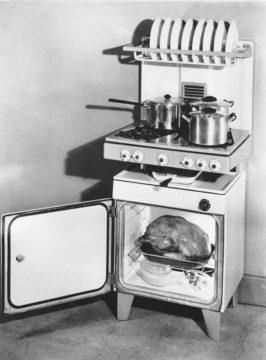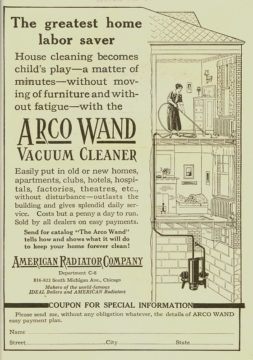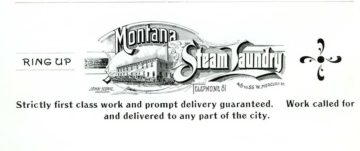by Rebecca Baumgartner
 In his book Enlightenment Now, when discussing the drastic improvements in quality of life over the past several decades, Steven Pinker says that “the liberation of humankind from household labor is in practice the liberation of women from household labor. Perhaps the liberation of women in general.” The most exciting promise of technology is that it will make being a human slightly less terrible. In the case of household appliances, the claim is that they will make being a woman slightly less terrible.
In his book Enlightenment Now, when discussing the drastic improvements in quality of life over the past several decades, Steven Pinker says that “the liberation of humankind from household labor is in practice the liberation of women from household labor. Perhaps the liberation of women in general.” The most exciting promise of technology is that it will make being a human slightly less terrible. In the case of household appliances, the claim is that they will make being a woman slightly less terrible.
Once women gained access to new labor-saving devices, the story goes, they were liberated from drudgery. We all seemingly agree that these innovations have given us our time back, shifting the role of the home from a place of production to a place of consumption. What used to be produced at home (often by women) is now purchased outside the home in the form of goods and services. Everybody wins! Progress has leveled the playing field and given women so much free time that they’re at liberty to enter the workforce in historically unprecedented numbers.
Well, hang on a minute. If these devices were supposed to create so much free time and lead to “the liberation of women in general,” then why do women continue to do significantly more household labor than men?
The Site of Industrialization is Where the Heart Is
Ruth Schwartz Cowan, a historian focused on the history of technology, shows us why this view of domestic technological progress is incomplete and overly simplistic. In her 1983 masterpiece of historical analysis, More Work for Mother: The Ironies of Household Technology from the Open Hearth to the Microwave, she steadily dismantles everything you think you know about so-called labor-saving devices and what modernity actually looks like in the home – a place, incidentally, that Cowan reminds us is “as much a locus for industrialized work as factories and coal mines are.” Or, to put it in even starker economic terms, “Households are the locales in which our society produces healthy people, and housewives are the workers who are responsible for almost all of the stages in that production process.”
The core question Cowan wants to answer is: When we talk about labor-saving devices, whose labor is saved, exactly? For Pinker and nearly everyone else, the answer is obvious: it’s women’s labor. But what Cowan’s analysis shows is that, during the industrial era, the household work traditionally performed by men became, for a variety of reasons, more completely replaced by technology than the household work traditionally performed by women. The story of how this happened, and why the reverse didn’t happen, is what More Work for Mother is about. The book’s key message is that household technologies primarily accelerated men’s, not women’s, entrance into the labor market outside the home. In fact, many of those technologies had unintended consequences that made it more likely a woman would need to continue working at home.
Even though it was written nearly 40 years ago, the premise of More Work for Mother remains just as relevant today. The exact technology may have changed, but the processes Cowan describes haven’t. Even the simple fact of recognizing that households are sites of production and a major part of the economy – not sheltered havens apart from it – is a relevant reminder for today. And the emphasis on household labor as labor, despite being unpaid and unaccounted for in a country’s GDP, is a concept that is increasingly voiced by progressive and feminist scholars writing about the causes of the gender pay gap and the justification for a Universal Basic Income.
To lay the groundwork for her analysis, Cowan describes what household work used to look like 200 years ago, and what is most unfamiliar to a modern audience is the extent to which, prior to industrialization, household work was an obligation shared equally by both men and women (and to a lesser, though still important extent, children). Out of necessity, running a household was very much a joint venture. The concept of household work being “women’s work” came later. Prior to industrialization, household work was everyone’s work. But gradually, with each new technological innovation that entered the home, men’s share of household work was largely replaced by market alternatives, while women’s remained largely the same – or even increased.
From Cornbread to Angel Food Cake

One of the surprising insights of More Work for Mother is how things we don’t typically think of as innovations actually had a radical effect on people’s day-to-day lives. Take, for example, white flour. Traditionally, most bread made in a household was quick bread (such as cornbread) which could be made, as the name implies, quickly and without relying on yeast cultures or rising time. Men played a significant role in the cornbread-making process: they shucked the corn and ground it into meal by hand or hauled it to the local grist mill for grinding. Over time, as refined white flour became widely available from large commercial flour mills, it replaced cornmeal as the household’s primary grain.
This shift from home-grown to store-bought grains relieved men and boys of one of their most time-consuming chores, while paradoxically increasing labor for women. This was because women were now expected to make more complex yeast breads that required more time, more skill, and more physical labor in the form of kneading dough. In short, men’s portion of bread labor disappeared, and women’s was augmented.
The same process occurred with the invention of stoves to replace hearths. Most pre-industrialization meals were usually a meat stew of some kind that was cooked in a single pot over a hearth, and people typically ate the same thing day after day. This task also involved men’s labor: they hauled the necessary wood to the kitchen every day. When stoves and ovens became affordable for most households, men’s contribution to the cooking process was no longer necessary, but women’s contribution remained just as burdensome as ever. On top of that, a skilled cook suddenly had the ability (and therefore, the obligation) to cook multiple different dishes simultaneously, spelling the end of the simple one-pot stew.
Vacuuming Alone
Cleaning rugs and carpets prior to the advent of the vacuum used to be a major undertaking, but crucially, it was a shared undertaking: the entire family participated and it only happened once or twice a year. The men of the household were responsible for carrying the rugs outside and hanging them up, and the children were responsible for beating the rugs to remove dust and dirt, after which the men would carry the rugs back inside the house. When vacuums were invented, this complex work process was distilled into one tool (the vacuum) and one person (the woman of the household).

What’s more, the invention of vacuum cleaners and their associated advertising created a demand for cleaner rugs, which meant that a task that had previously been performed annually was now being performed weekly or monthly. Keeping all of these facts in mind, Cowan concludes that “the question of whether cleaning a rug has been made easier or faster by the advent of vacuum cleaners becomes considerably more difficult to answer. Easier for whom? Faster for whom? Under what conditions?”
It’s also interesting to look at how this chore, and many others like it, changed from a psychological point of view. Not only did the use of the vacuum lead to a more unequal distribution of labor in the household, it also made the chore of cleaning carpets more isolating for the one doing the labor. This is ultimately not just about sheer hours worked; it’s also about who has to be tethered to a tool, tethered to the home, who is working alone, and who gets to explore other options and engage with other people. As Cowan points out, “Angel food cakes, strawberry preserves, clean clothes, ironed ruffles, and leavened bread may have made life easier and pleasanter for their families, but they also kept women working at home.”
By contrast, it’s easy to imagine how lively and energetic the traditional rug-beating day must have been: the bustle and noise of family members lugging heavy rugs and chatting or complaining during a chore that was an annual harbinger of spring. When this labor was “saved,” or rendered unnecessary for the men and children of the household, the alternative scenario became more bleak: a woman, by herself, pushing a vacuum back and forth across a carpet, the only sound a mechanical one. For many women, no doubt, the loss of camaraderie created by communal housework was just as painful as the resentment of seeing the benefits of industrialization accrue mostly to her husband.
Insourcing the Dreaded Laundry Day
As unpleasant as cooking and vacuuming could be, doing laundry prior to the invention of washing machines was the “back-breaking chore that no one wants to do” par excellence. However, throughout the nineteenth century and the first part of the twentieth century, most middle-class families weren’t breaking their own backs – they outsourced this labor by sending their laundry to commercial agencies. When washing machines became commonplace in middle-class households, the work that had previously been outsourced to others was suddenly done by the woman of the household. In addition, the advent of manufactured cloth increased the amount of clothing a middle-class person was expected to own; in previous generations, most people had only one or two outfits, which were washed infrequently.

As Cowan puts it: “The advent of the electrically powered washing machines (as well as of synthetic washable fabrics) coincided with the advent of ‘do-it-yourself’ laundry, so that the woman endowed with a Bendix [a popular brand of washing machine] would have found it easier to do her laundry but, simultaneously, would have done more laundry, and more of it herself, than either her mother or her grandmother had.” Women had never previously cleaned their floors once a week or cleaned their family’s clothing after only one wear, but now they felt compelled to. Hence, more work for mother – and not in spite of technological progress, but because of it.
This Isn’t the Revolution You’re Looking For
Historically, whenever something has been hailed as a labor-saving device for the home, the labor it saves is male. For men and children, the home was gradually transformed from a place of domestic work into a place of leisure and rest, a peaceful haven away from the factory and the schoolroom. But for women, the home demanded as much upkeep as ever. They were just having to do it alone now.
The greatest insight of Cowan’s book is that every innovation is embedded in a system of other pre-existing tools and practices and has an effect on them that is not necessarily predictable or accounted for in traditional narratives about how a task gets done. When one part of a task is removed or streamlined, what is it replaced with?
Using the framework of More Work for Mother, whenever we’re told a new appliance is a “game changer” (take, for example, the current obsession with the Instant Pot), we should ask questions like: Who spent the time crawling through Amazon reviews researching which pressure cooker to buy? Who had to read through the instruction manual to learn how to use the thing? Who finds recipes that are suited for it? Who washes it? Who sets it up correctly to make sure it doesn’t explode all over the kitchen? Is there a new expectation to cook more meals at home because of this tool? Unless the cook’s labor previously included lots of home cooking and hours of research, manual-reading, and explosion-monitoring, this is additional labor, which must be factored into the accounting before we declare whether an appliance has ultimately saved any labor…or not.
Those types of questions are, as Cowan admits, “complications that may be annoying,” but these complications bring into focus the essential features of how we get work done in our homes, why the quantity of that work is still so lopsided along gender lines, and why we should remain curious and skeptical enough to discover which innovations truly result in a net reduction of labor, and which just lead to more work for mother.
